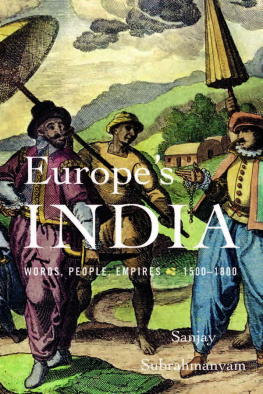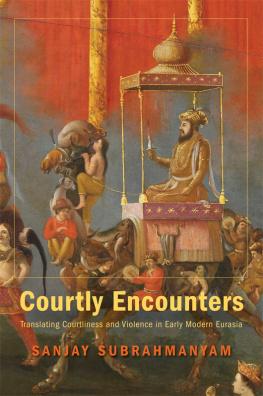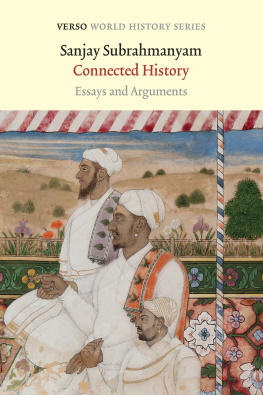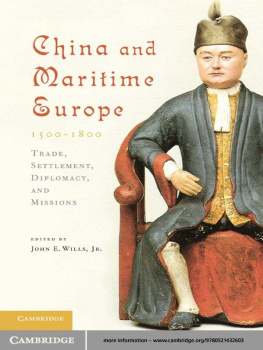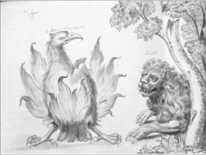Empires Between Islam
and Christianity
15001800
SUNY series in Hindu Studies
WENDY DONIGER, EDITOR
Empires Between Islam
and Christianity
15001800
Sanjay Subrahmanyam
Empires between Islam and Christianity, 15001800 by Sanjay Subrahmanyam was first published by Permanent Black D-28 Oxford Apts, 11 IP Extension, Delhi 110092 INDIA, for the territory of SOUTH ASIA.
Not for sale in South Asia
Cover design by Anuradha Roy
Published by State University of New York Press, Albany
2019 Sanjay Subrahmanyam
All rights reserved
Printed in the United States of America
No part of this book may be used or reproduced in any manner whatsoever without written permission. No part of this book may be stored in a retrieval system or transmitted in any form or by any means including electronic, electrostatic, magnetic tape, mechanical, photocopying, recording, or otherwise without the prior permission in writing of the publisher.
For information, contact State University of New York Press, Albany, NY
www.sunypress.edu
Library of Congress Cataloging-in-Publication Data
Names: Subrahmanyam, Sanjay, author.
Title: Empires between Islam and Christianity, 1500-1800 / Sanjay Subrahmanyam.
Description: Albany : State University of New York Press, [2019] | Series: SUNY series in Hindu studies | Empires between Islam and Christianity 1500-1800 by Sanjay Subrahmanyam was first published by Permanent Black-- Title verso. | Includes bibliographical references and index.
Identifiers: LCCN 2018027696| ISBN 9781438474359 (hardcover : alk. paper) | ISBN 9781438474366 (e-book)
Subjects: LCSH: World history. | History, Modern. | East and West. | Imperialism.
Classification: LCC D22 .S83 2019 | DDC 909.08--dc23 LC record available at https://lccn.loc.gov/2018027696
10 9 8 7 6 5 4 3 2 1
for
CAROLINE
Contents
MAPS AND ILLUSTRATIONS
Preface
T HE WORK GATHERED TOGETHER in this book has percolated for a time, though most of it was written over the past decade and a half. The subject of empire has preoccupied me almost since the beginning of my academic career, more so since the late 1980s. Its first explicit manifestations came in the form of two books, one published in 1990 on how the Portuguese improvised an empire in the Bay of Bengal, and the other a far more general (and inevitably better-known) book from 1993 on the political economy of the Portuguese empire in Asia between 1500 and 1700. By the time this second work appeared, I had already taken the first somewhat tentative steps towards the study of another, quite different, empire that of the Indian Timurids, or Mughals mostly in collaboration with my dear friend and colleague Muzaffar Alam (though I have also occasionally ventured to publish essays on Mughal history on my own). Together we first published a reader on Mughal history in the late 1990s, following it up about a decade later with a jointly authored book on travel accounts in the Mughal world. Then, in the early 2010s, we brought together a sizeable collection of our jointly authored essays on Mughal themes.
At the same time, my interest in the Ottoman empire and its history has been with me from the late 1980s, starting with a series of conferences at Munich, Boston, and elsewhere (organised by Suraiya Faroqhi and others), that brought sheltered Indian historians such as myself and Muzaffar Alam into regular contact with our sophisticated Ottomanist counterparts like Cornell Fleischer and Cemal Kafadar, who have been wonderful (albeit intermittent) conversational partners. I have been a voracious reader ever since of the rich historiography on the Ottomans, and I am grateful to my many friends and colleagues in that field for their indulgence in the face of my regular transgressions. Less systematically, I have kept up to the extent possible with writings on Ming and Qing China, thanks to colleagues such as Timothy Brook, Richard von Glahn, and R. Bin Wong with the last of whom I co-taught a seminar over several years at UCLA. It was considerably easier, for linguistic reasons, for me to traverse the porous frontier between the Portuguese and Spanish empires, a process that took shape in the short decade or so (between 1995 and 2004) that I taught at the Ecole des Hautes Etudes en Sciences Sociales in Paris, with Serge Gruzinski, Carmen Salazar-Soler, Nathan Wachtel, and others.
This book is, in short, the consequence of constant intellectual trespassing born of curiosity. It is probably the perverse outcome of my having been brought up in the intellectual milieu of Delhi, where hardly anyone had dared by the 1980s to venture out of the stifling straitjacket of Indian history. Luckily, I was not trained there as a historian but as an economist, in the midst of a far more adventurous and ambitious tribe of them, and I found their horizons far wider than those of Indian historians. This was so to the point that my mentor, the late Dharma Kumar, warned me against leaving the safe confines of an Indian economics department for a history department for fear of the provincialism of historians! I did not heed her advice.
Besides those mentioned above, there are others I should thank and for a variety of reasons. Several chapters of this book draw directly on the work and influence of the late Jean Aubin, who studied the Timurids, the Safavids, and the Portuguese with equal diligence and talent. For help and advice with Portuguese materials, I must also mention Jorge Flores and Lus Filipe Thomaz, both friends now of very long standing. Helpful comments or hints regarding one or the other chapter came from Perry Anderson, Evrim Binba, John Elliott, Antonio Feros, Carlo Ginzburg, Claude Guillot, Valerie Kivelson, Giuseppe Marcocci, Claude Markovits, Anna More, Matthew Mosca, Geoffrey Parker, Kapil Raj, and Stuart Schwartz. I am particularly grateful to Anthony Pagden, who co-authored one of these chapters, and with whom I organised a series of meetings in 20067 at UCLA on Imperial Models in the Early Modern World.
In earlier shapes these chapters have appeared before, but they have been revised, at times extensively, and rendered more coherent for the purposes of this book. Their earlier appearance in print is as follows:
The Birth-Pangs of Portuguese Asia: Revisiting the Fateful Long Decade 14981509, Journal of Global History, vol. 2, no. 3, 2007, pp. 26180.
Semper per viam portugalensem: Of Italians, Portuguese, and the Indian Ocean, Purusrtha, no. 35 (LInde et lItalie), 2018.
What the Tamils Said: A Letter from the Kelings of Melaka (1527), Archipel, no. 82, 2011, pp. 13758.
Holding the World in Balance: The Connected Histories of the Iberian Overseas Empires, 15001640, American Historical Review, vol. 112, no. 5, 2007, pp. 135985.
A Tale of Three Empires: Mughals, Ottomans and Habsburgs in a Comparative Context, Common Knowledge, vol. 12, no. 1, 2006, pp. 6692.
(With Anthony Pagden) Roots and Branches: Ibero-British Threads across Overseas Empires, in Per Adriano Prosperi, Vol. 2: LEuropa divisa e i Nuovi Mondi, ed. Massimo Donattini, Giuseppe Marcocci, and Stefania Pastore, Pisa: Edizioni della Normale, 2011, pp. 279301.
On World Historians in the Sixteenth Century, Representations, no. 91, Fall 2005, pp. 2657.


